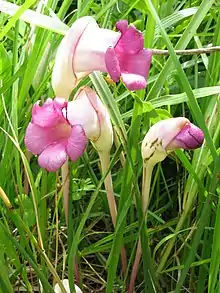| Aeginetia | |
|---|---|
 | |
| Aeginetia sinensis | |
| Scientific classification | |
| Kingdom: | Plantae |
| Clade: | Tracheophytes |
| Clade: | Angiosperms |
| Clade: | Eudicots |
| Clade: | Asterids |
| Order: | Lamiales |
| Family: | Orobanchaceae |
| Tribe: | Buchnereae |
| Genus: | Aeginetia L.[1] |
| Species | |
|
See text | |
| Synonyms[1] | |
| |
Aeginetia is a genus of plants in the broomrape family Orobanchaceae, native mostly to tropical Asia and also Cameroon (in Africa).[1]
I is found within Assam, Bangladesh, Borneo, Cambodia, southern China, East Himalaya, India, Japan, Jawa, Korea, Laos, Malaya, Myanmar, Nansei-shoto, Nepal, New Guinea, Ogasawara-shoto, Philippines, Sri Lanka, Sulawesi, Sumatera, Taiwan, Thailand and Vietnam.[1]
The genus name of Aeginetia is in honour of Paul of Aegina (c. 625 – c. 690), a Byzantine Greek born physician best known for writing the medical encyclopedia, Medical Compendium in Seven Books.[2] It was first described and published in Sp. Pl. on page 632 in 1753.[1]
Species
As of May 2020, Plants of the World Online recognises the following species:[1]
- Aeginetia acaulis (Roxb.) Walp. (synonym A.sessilis Shivam. & Rajanna)[3]
- Aeginetia flava J.Parn.
- Aeginetia indica L.
- Aeginetia mirabilis (Blume) Bakh.
- Aeginetia mpomii Letouzey
- Aeginetia selebica Bakh.
- Aeginetia sinensis Beck
References
- 1 2 3 4 5 6 "Aeginetia". Plants of the World Online. Royal Botanic Gardens, Kew. Retrieved 20 May 2020.
- ↑ Burkhardt, Lotte (2018). Verzeichnis eponymischer Pflanzennamen – Erweiterte Edition [Index of Eponymic Plant Names – Extended Edition] (pdf) (in German). Berlin: Botanic Garden and Botanical Museum, Freie Universität Berlin. doi:10.3372/epolist2018. ISBN 978-3-946292-26-5. Retrieved 1 January 2021.
- ↑ Nuraliev MS et al. (2023) Sorting out Aeginetia (Orobanchaceae) in Indochina: A. sessilis is a synonym of A. acaulis Phytotaxa, 597 [4]: 17 May 2023